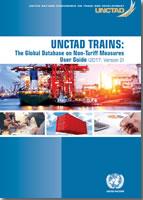
Trade patterns and policies have become more complex and multi-faceted. The ability to gain and to benefit from market access depends increasingly on compliance with trade regulatory measures such as sanitary and quality requirements for goods. Such Non-Tariff Measures (NTMs) represent a growing challenge for exporters, importers and policy makers. Due to their important primary objectives (e.g. protection of health or the environment) these types of measures cannot simply be eliminated. Other trade and trade related policies include price and quantity measures, licensing requirements, subsidies, competition related polices, export measures, etc.
Businesses, policy makers, trade negotiators and researchers are often hindered by a lack of clear and systematic information about such policies. The objective of the TRAINS database is to increase the transparency in the use of policy instruments affecting international trade by providing information on regulations and trade control measures.
In 1994, UNCTAD began to collect and classify NTMs in order to give due consideration to the increasing complexity of trade policy instruments. In 2006, UNCTAD’s Secretary General established the Group of Eminent Persons on Non-tariff Barriers (GNTB), composed of leading economists. A Multiagency Support Team (MAST) group composed of experts from international agencies, namely Food and Agriculture Organization (FAO), International Monetary Fund (IMF), International Trade Centre (ITC), Organization of Economic Cooperation and Development (OECD), UNCTAD, United Nations Industrial Development Organization (UNIDO), the World Bank, and World Trade Organization (WTO) provided substantial support to the GNTB (UNCTAD, 2009). The GNTB provided a definition for NTMs and the MAST group a related taxonomy that allows the detailed classification and development of a database of NTMs.
The International Classification of NTMs2 covers all NTMs and distinguishes at the most detailed level 177 types of measures. This classification is a common language of NTMs and designed to facilitate the collection, analysis and dissemination of data on NTMs, with the final objective to increase transparency and understanding about the subject.
The Transparency in Trade initiative (TNT), launched by UNCTAD, the African Development Bank, ITC and the World Bank in 2012 aims to enhance availability and accessibility of trade data. UNCTAD has developed a standardized approach to collect NTM data and coordinates the global effort in NTMs data collection. Our partners are the African Development Bank, Latin American Integration Association (ALADI), Economic Research Institute for ASEAN and South East Asia (ERIA), National Graduate Institute for Policy Studies (GRIPS), ITC, United Nations Economic Commission for Europe, World Bank and World Trade Organisation.
The collection of data on NTMs is complex and resource intensive. It entails the identification regulatory policies that can have an effect on trade and classification of them according to codes of the International Classification of Non-tariff Measures, as well as identifying the products codes for the goods to which measures apply.
The information about the policies stems from official legal documents such as laws, regulations, directives, decrees and rules. Data is then published through several dissemination tools, notably UNCTAD TRAINS database accessible through UNCTAD TRAINS (trains.unctad.org) and WITS (wits.worldbank.org). The same data is also accessible for private sector users in ITC MacMap. A researcher file is available for download at trains. unctad.org (analysis) showing processed data at HS6 digit level.
The purpose of this manual is to provide information for users of the TRAINS database about the NTMs data structure and data collection process. It explains the classification and to what extent and how the consistency among different countries and comprehensiveness of regulations have been achieved. It also indicates how to read the data and its different variables presented through all dissemination tools mentioned above.
This manual has been created with the intention of covering a wide range of issues of interest for database users. However, if uncertainties still persist, users are encouraged to read the guidelines to collect NTMs. If questions remain, please submit them to trains@unctad.org.


